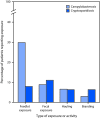Occupational Animal Exposure Among Persons with Campylobacteriosis and Cryptosporidiosis - Nebraska, 2005-2015
- PMID: 28910275
- PMCID: PMC5657915
- DOI: 10.15585/mmwr.mm6636a4
Occupational Animal Exposure Among Persons with Campylobacteriosis and Cryptosporidiosis - Nebraska, 2005-2015
Abstract
Campylobacter and Cryptosporidium are two common causes of gastroenteritis in the United States. National incidence rates measured for these pathogens in 2015 were 17.7 and 3.0 per 100,000 population, respectively; Nebraska was among the states with the highest incidence for both campylobacteriosis (26.6) and cryptosporidiosis (≥6.01) (1). Although campylobacteriosis and cryptosporidiosis are primarily transmitted via consumption of contaminated food or water, they can also be acquired through contact with live animals or animal products, including through occupational exposure (2). This exposure route is of particular interest in Nebraska, where animal agriculture and associated industries are an important part of the state's economy. To estimate the percentage of disease that might be related to occupational animal exposure in Nebraska, the Nebraska Department of Health and Human Services (NDHHS) and CDC reviewed deidentified investigation reports from 2005 to 2015 of cases of campylobacteriosis and cryptosporidiosis among Nebraska residents aged ≥14 years. Case investigation notes were searched for evidence of occupational animal exposures, which were classified into discrete categories based on industry, animal/meat, and specific work activity/exposure. Occupational animal exposure was identified in 16.6% of 3,352 campylobacteriosis and 8.7% of 1,070 cryptosporidiosis cases, among which animal production (e.g., farming or ranching) was the most commonly mentioned industry type (68.2% and 78.5%, respectively), followed by employment in animal slaughter and processing facilities (16.3% and 5.4%, respectively). Among animal/meat occupational exposures, cattle/beef was most commonly mentioned, with exposure to feedlots (concentrated animal feeding operations in which animals are fed on stored feeds) reported in 29.9% of campylobacteriosis and 7.9% of cryptosporidiosis cases. Close contact with animals and manure in feedlots and other farm settings might place workers in these areas at increased risk for infection. It is important to educate workers with occupational animal exposure about the symptoms of enteric diseases and prevention measures. Targeting prevention strategies to high-risk workplaces and activities could help reduce disease.
Conflict of interest statement
Figures
Similar articles
-
Occupational Distribution of Campylobacteriosis and Salmonellosis Cases - Maryland, Ohio, and Virginia, 2014.MMWR Morb Mortal Wkly Rep. 2017 Aug 18;66(32):850-853. doi: 10.15585/mmwr.mm6632a4. MMWR Morb Mortal Wkly Rep. 2017. PMID: 28817554 Free PMC article.
-
Genotyping and Subtyping Cryptosporidium To Identify Risk Factors and Transmission Patterns - Nebraska, 2015-2017.MMWR Morb Mortal Wkly Rep. 2020 Mar 27;69(12):335-338. doi: 10.15585/mmwr.mm6912a4. MMWR Morb Mortal Wkly Rep. 2020. PMID: 32214081 Free PMC article.
-
Occupational risk of salmonellosis and campylobacteriosis: a nationwide population-based registry study.Occup Environ Med. 2019 Sep;76(9):617-624. doi: 10.1136/oemed-2019-105868. Occup Environ Med. 2019. PMID: 31413185
-
Campylobacteriosis Outbreak Linked to Municipal Water, Nebraska, USA, 20211.Emerg Infect Dis. 2024 Oct;30(10):1998-2005. doi: 10.3201/eid3010.231509. Emerg Infect Dis. 2024. PMID: 39320141 Free PMC article. Review.
-
Campylobacteriosis - an overview.Mymensingh Med J. 2014 Jan;23(1):173-80. Mymensingh Med J. 2014. PMID: 24584395 Review.
Cited by
-
Association of Common Zoonotic Pathogens With Concentrated Animal Feeding Operations.Front Microbiol. 2022 Jan 10;12:810142. doi: 10.3389/fmicb.2021.810142. eCollection 2021. Front Microbiol. 2022. PMID: 35082774 Free PMC article. Review.
-
Enteric Disease Outbreaks Associated with Animal Contact - Animal Contact Outbreak Surveillance System, United States, 2009-2021.MMWR Surveill Summ. 2025 May 22;74(3):1-12. doi: 10.15585/mmwr.ss7403a1. MMWR Surveill Summ. 2025. PMID: 40392712 Free PMC article.
-
Molecular epidemiologic tools for waterborne pathogens Cryptosporidium spp. and Giardia duodenalis.Food Waterborne Parasitol. 2017 Sep 29;8-9:14-32. doi: 10.1016/j.fawpar.2017.09.002. eCollection 2017 Sep-Dec. Food Waterborne Parasitol. 2017. PMID: 32095639 Free PMC article. Review.
-
Animal agriculture exposures among Minnesota residents with zoonotic enteric infections, 2012-2016.Epidemiol Infect. 2020 Mar 16;148:e55. doi: 10.1017/S0950268819002309. Epidemiol Infect. 2020. PMID: 32172700 Free PMC article.
-
Local and Global Public Health and Emissions from Concentrated Animal Feeding Operations in the USA: A Scoping Review.Int J Environ Res Public Health. 2024 Jul 13;21(7):916. doi: 10.3390/ijerph21070916. Int J Environ Res Public Health. 2024. PMID: 39063493 Free PMC article.
References
-
- Painter JE, Hlavsa MC, Collier SA, Xiao L, Yoder JS. Cryptosporidiosis surveillance—United States, 2011–2012. MMWR Surveill Summ 2015;64(No. SS-3):1–14. - PubMed
MeSH terms
Grants and funding
LinkOut - more resources
Full Text Sources
Other Literature Sources
Medical


